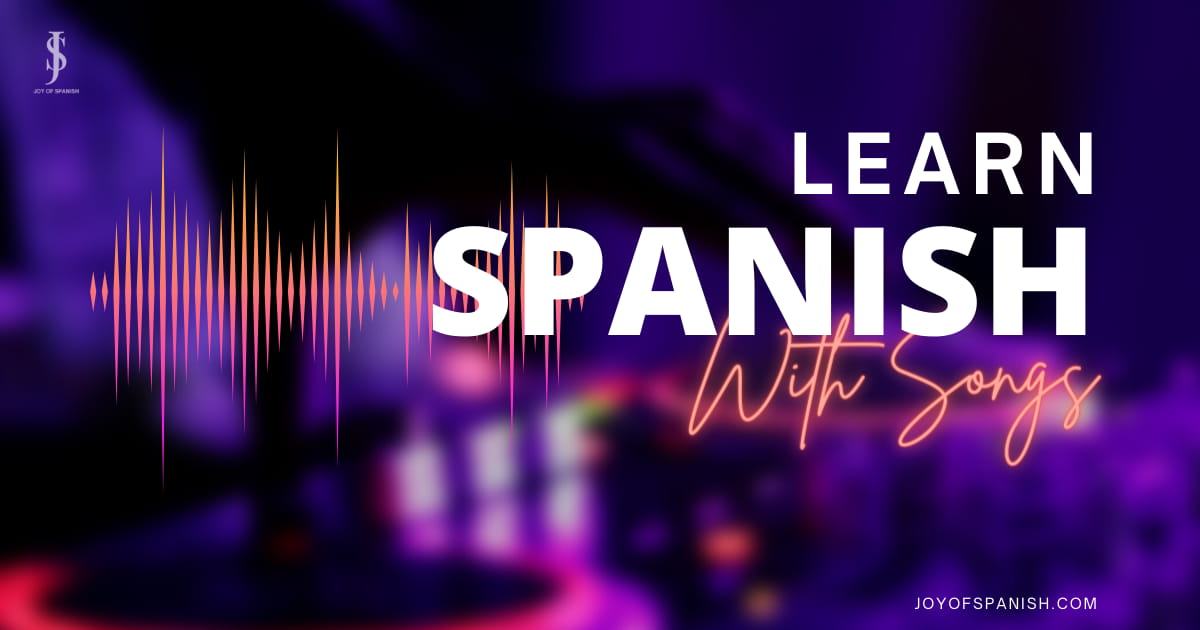Do you enjoy music and studying the Spanish language? If so, you can combine the two to take your learning experience to the next level.
Music can be an amusing way to learn a language. Spanish songs make it easier. It helps us to remember words and phrases with rhythmic beats and repetitive patterns.
Listening to music and lyrics can connect words with emotions. This makes them more unique and pleasant.
In short, music has a unique role in language learning.
Table of Contents
About the Spanish Music and Songs
Spanish is known for its rich history, varied Spanish dialects, and colorful idioms. It is a top language for business, diplomacy, and cultural exchange.
Spanish is one of the most romantic languages with a long musical history. The expressive sound is music-to-ear.
Spanish music has a rich and diverse past. It’s been part of Spanish culture for centuries. As a result, it has developed into different styles and genres.
Spain is known worldwide for its famous lyrical styles. Jota, flamenco, and classical guitar are some examples. Even in present-day pop music, you can hear the impact of Spanish passion, rhythm, tempo, and lyrics.
Music is also a vital part of the cultural heritage in many Latin American nations. The inspiration comes from the customs and traditions of various Hispanophone countries.
We can gain insight into diverse places and people through their music. This permits us to dive deep into their culture.
If you’re in the music industry or planning to be, there’s a good reason to learn Spanish.
The Spanish language matters in business because of the interconnected globe. The diverse variations and passionate culture make it one of the top choices as a hobby.
You can also explore plenty of jobs that require Spanish.
How does Spanish music help in learning Spanish?
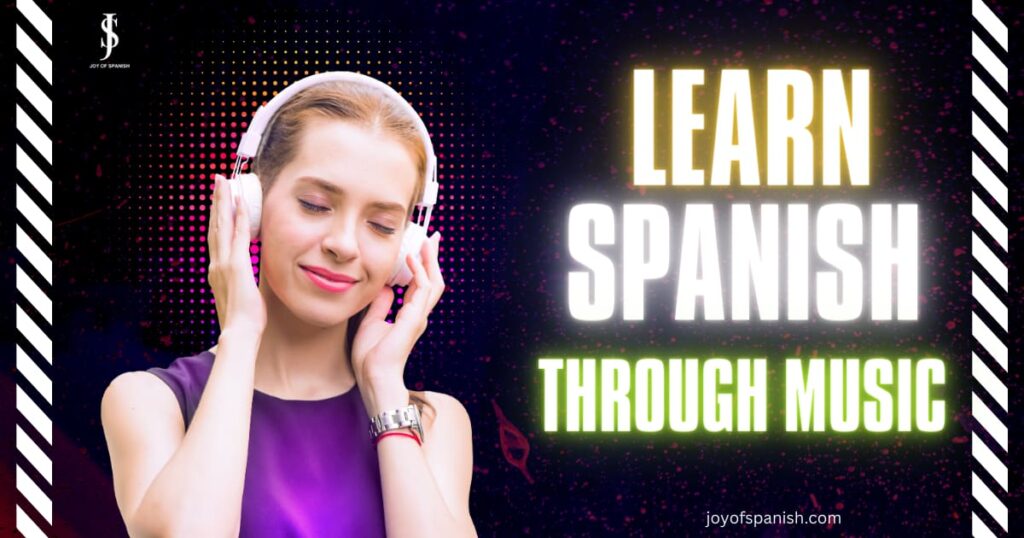
Spanish music can be a practical and enjoyable tool for learning Spanish. It can support you in improving your language skills.
Here are several ways in which Spanish music can support your learning journey.
1. Improve listening skills by focusing on pronunciation
Learning Spanish through music is a lovely experience. It enables you to tune yourself to its pronunciation and accents.
You can mimic the sound of native Spanish singers. It improves your intonation. So this makes your speech more natural and authentic.
By listening to a native musician and singer, you get a feel for the language’s rhythm and articulation. As a result, it helps your overall Spanish listening skills.
The Spanish songs can enhance your listening comprehension skills. It helps you understand spoken Spanish faster and with various accents.
2. Learn vocabulary and grammar rules
The song’s lyrics comprise plenty of words, phrases, and expressions. It can enhance your vocabulary.
You will comprehend the language used in everyday speech. You can also learn new words and idiomatic expressions and notice how to use them in context.
Songs often show the correct use of grammar, verb conjugations, and sentence structure. You can see how to apply different verb tenses and grammatical rules in real-life situations.
Spanish music covers many genres, from pop and rock to reggaeton, salsa, flamenco, and more. This lets you explore different styles and words used in various genres.
3. Cultural insight, context, and real
Listening to songs and lyrics can give you more genuine exposure to the language than standard courses.
Spanish music offers a glimpse into Spanish-speaking countries’ culture, history, and experiences. The context and themes of songs can deepen your cultural appreciation.
You can discover how context makes you a better language learner. You know how to use real-world informal idioms.
4. Motivation and engagement
Music is enjoyable and motivating. This can encourage Spanish learners.
You may find yourself more inclined to learn and practice Spanish through music. This is because of the pleasure it brings.
How to use Spanish music to enhance your Spanish learning
You can use Spanish songs regularly as a supplement tool alongside other study methods.
You enrich your listening skills, vocabulary, grammar comprehension, and cultural understanding. It also adds delight and creativity to your learning process.
There are many activities to make the most of Spanish music for language learning. Here are some top methods that can help.
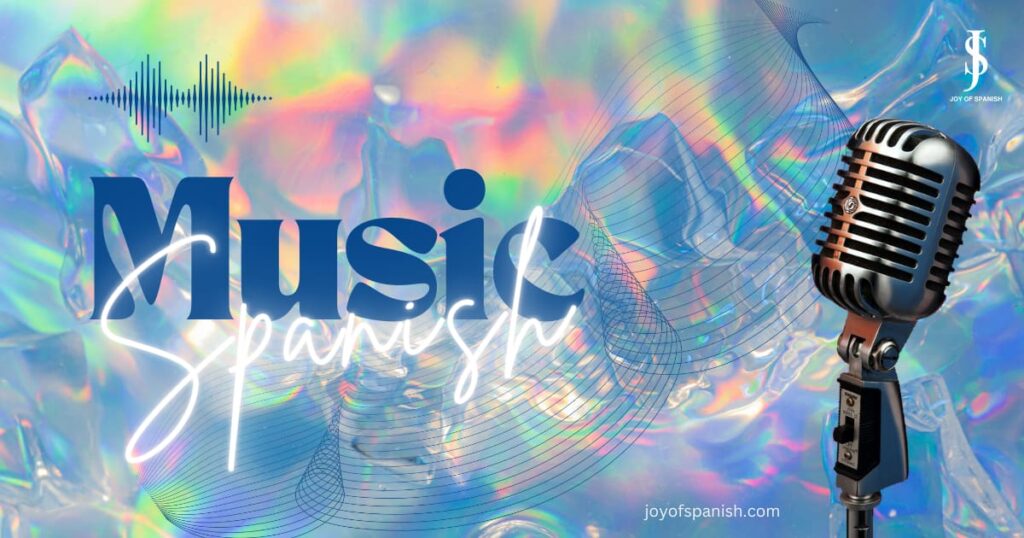
1. Use Spanish music as a tool for entertainment
You can create playlists of songs that match your current language level and preferences.
Listening to Spanish music while learning can make the process more effective and enjoyable. It can boost your understanding of the language.
You can immerse yourself in various enjoyable forms of it. For example, TV shows, music, and Spanish films for learners.
You can create flashcards for the new words you’ve learned from the song. Use Spanish words on one side and the translation on the other. Then, review them to reinforce your memory.
It aids in the development of your listening and comprehension skills. You expand your wording and know how to use phrases in context correctly.
2. Repeat singing the lyrics multiple times
Singing and repeating song lyrics can help with correct pronunciation practice.
Spanish songs have catchy and upbeat rhythms that make them easy to listen to on repeat! It can expose you to different language styles, terms, and cultural contexts.
By doing this, you focus on the sounds and rhythm of the words. This raises your knowledge of phonetics. It’s easy to memorize new words, phrases, and expressions because of their tempo and vocals.
Initially, you can hear the song without reading the lyrics. Listen to it again while reading them. Search for definitions of unfamiliar words and grasp their usage.
Finally, give singing along with the song on repeat a shot.
3. Translate the lyrics
If you translate a song’s Spanish lyrics, you can better understand the importance and context of the words and phrases used.
Consider the context of the words and phrases for translating Spanish song lyrics. You can’t translate cultural relations and expressions directly.
The lyrics are often poetic. This makes it challenging to translate because of the complex emotional expression.
Share the song and its lyrics with fellow Spanish learners or natives. Discuss the song’s meaning, cultural references, and any themes or messages it conveys.
Finally, try to interpret the meaning.
You can achieve cheerful and effective language learning by translating Spanish song lyrics.
4. Search for the definitions of unknown words
If you find an unknown word, try finding its meaning by looking it up. You can improve your language understanding and grow your vocabulary with this.
Learning Spanish includes the aspect of increasing your word power, phrases, and their meanings. You get better at reading, listening, writing, and speaking with it.
Several options are available for searching for words.
You could use a dictionary or translation apps. You can also explore the phrase online. It is necessary to understand the background and use reliable sources.
5. Improve speaking and listening skills with music
Music is an excellent resource for enhancing listening and speaking ability. It helps differentiate sounds, rhythms, intonations, and word expressions.
Listen to a song without checking the lyrics and test your comprehension.
Your listening skills can improve with this. You can become more familiar with the commonly used vocabulary and grammar structures.
Simple lyrics and slow-paced songs are ideal for beginners. In contrast, advanced learners may prefer faster-paced songs. This includes more complex lyrics to push themselves.
6. Track Your Progress
Keep a language journal to track your progress.
You can note the vocabulary and phrases you’ve learned from each song. Reflect on how your understanding of the language has improved.
Initially, begin by listening to the song without looking at the lyrics.
Focus on the melody, rhythm, and flow of the language. Get a sense of the mood and style of the song.
You can also sing along to the song to practice pronunciation and rhythm. This active engagement deepens your understanding and retention of the language.
Pay attention to the way the singer focuses on certain words or syllables. Mimic their pronunciation as closely as possible.
Spanish songs for kids
Many songs are suitable for kids to listen to as they learn Spanish with songs. Here are a few examples.
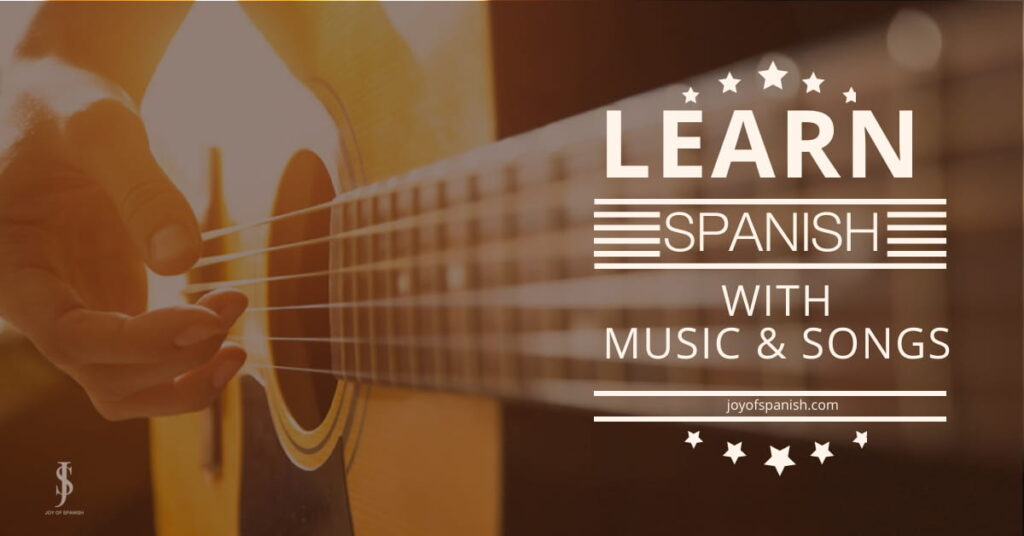
1. El Baile del Sapo (The Frog Dance)
“El Baile del Sapo” is a popular Spanish-language song that originated in Venezuela. The title translates to “The Dance of the Toad” in English.
This song is known for its catchy melody. The musical theme and danceable rhythm are about a frog who loves to dance and is perfect for kids who enjoy moving to music.
2. Cinco Patitos (Five Little Ducks)
“Cinco Patitos” is a traditional Spanish children’s song. It translates to “Five Little Ducks” in English.
This song is to teach young children counting and basic vocabulary. It’s a splendid way to introduce kids to counting in Spanish.
The song continues with the same pattern, with each verse counting down the number of little ducks that return to Mama Duck. The simple and repetitive nature makes it easy for children to remember Spanish.
3. La Mano Arriba (Hands Up)
This fun, energetic song is excellent for getting kids moving and dancing.
“La Mano Arriba” is a Spanish song by the Chilean band Ráfaga. The title translates to “Hand Up” in English.
The song is known for its tempo and catchy melody. It is usually played in dance clubs and parties in Central and South America.
4. La Gallina Turuleca (The Fussy Hen)
“La Gallina Turuleca” is a Spanish children’s song. It narrates the story of a fussy hen who doesn’t like her life on the farm and dreams of a better life.
This vibrant song is about a hen always fussing about something. The music has been popular in Spain and Latin America for many years and has been covered by various artists.
5. El Elefante (The Elephant)
“El Elefante” is a traditional Spanish children’s song that translates to “The Elephant” in English. This simple, catchy song about an elephant is perfect for kids just learning Spanish.
The song continues with each piece of poetry, adding another elephant to the swinging group until they all fall off and go to bed.
The easy and repetitive character of the music makes it easy for children to learn and sing along.
Top Spanish Songs for learning Spanish
Many popular songs in Spanish can be helpful for learners of the language. They represent various genres, including rock, pop, salsa, and more.
They are popular Spanish-language songs that have gained international recognition. They are favored among Spanish speakers worldwide.
Here are some famous ones that are often recommended for language learners.
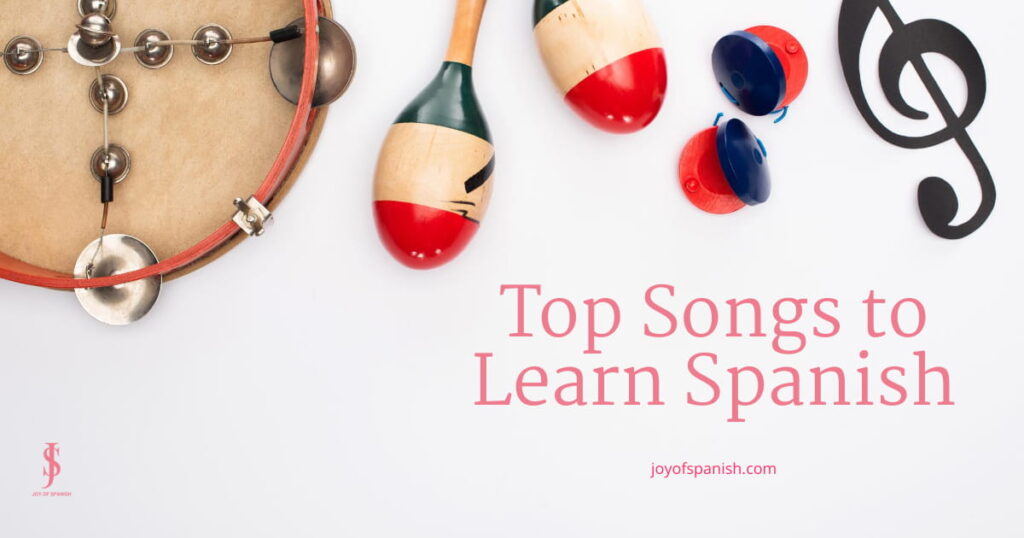
1. Despacito by Luis Fonsi
“Despacito” is a Spanish-language song by Puerto Rican singer Luis Fonsi. It stars Puerto Rican rapper Daddy Yankee.
This song is often used in Spanish language classes and apps to practice Spanish. You also learn many new words.
They released the song in 2017 and quickly became a global sensation. It broke records and became one of the most streamed and watched videos on YouTube.
2. Amor Prohibido by Selena
“Amor Prohibido” of 1994 is a classic Spanish song by the late Tejano music superstar Selena.
The passionate vocals and energetic rhythm have made it a favorite among Selena’s and Tejano music fans.
The song narrates the story of a forbidden love between two people from different social classes. This is a common theme in many Latin American songs and stories.
3. Baila Morena by Zucchero
“Baila Morena” is a Spanish song by Italian singer-songwriter Zucchero, released in 2004. The song has a lively tempo and is sung in Spanish and Italian.
The lyrics inspire a woman to dance and let loose, celebrating her beauty and spirit.
The mix of Spanish and Italian adds to the song’s global appeal. It’s a favorite among Latin and pop music fans because of its melody and rhythm.
4. Sueños by Natti Natasha
“Sueños” song is a Dominican singer-songwriter Natti Natasha released in 2020. The song has a romantic tone. The lyrics depict the singer’s desire to find true love and happiness.
This reggaeton-style song features a catchy beat and simple, repetitive lyrics. It is easy to learn.
The song’s catchy melody and festive spirit have made it a hit with fans of Hispanic music globally. It is an excellent example of how music can celebrate diversity and promote cross-cultural awareness.
5. “La Bamba” by Ritchie Valens
“La Bamba” is a traditional Mexican folk song popularized by Ritchie Valens. He was a Chicano rock and roll singer in the late 1950s.
The song has a fast-paced rhythm and catchy melody, making it a Latin American music genre classic. This classic is often played at parties and celebrations and has been covered by many artists since.
The lyrics celebrate the pleasure and excitement of dancing. It describes the steps and movements needed to perform the Bamba, a traditional dance from Veracruz, Mexico.
The chorus has the repeated phrase “Yo no soy marinero, soy capitán” (I am not a sailor, I am a captain), a lively reference to taking charge and leading the dance.
6. La Bicicleta by Carlos Vives and Shakira
“La Bicicleta” is a Spanish song by Colombian singers Carlos Vives and Shakira, released in 2016. The song has an optimistic rhythm. It celebrates Colombia’s natural beauty and cultural richness.
The lyrics describe the singers’ journey through various Colombian cities and regions. They meet different people and experiences contributing to their national identity and pride.
The chorus repeats “Que Viva la Bicicleta” (Long live the bicycle). It is a living metaphor for simple pleasures. Also, the importance of staying grounded in one’s roots and culture.
7. “Himno de mi Corazón,” by Jesse & Joy
“Himno de mi Corazón” in 2019 is a Latin song by Mexican-American brother-sister duo Jesse & Joy. It has a mellow and romantic tone.
The choir has the repeated phrase “Eres el himno de mi corazón” (You are the anthem of my heart). It represents the singer’s deep and enduring love for their partner.
The song’s lyrics describe the bond between two people deeply in love and the comfort and security of being with that person.
8. “Vivir Mi Vida” by Marc Anthony
“Vivir Mi Vida” is a song by Puerto Rican-American singer Marc Anthony, released in 2013. The song has a positive and energetic rhythm. The lyrics encourage living life to the fullest and embracing happiness and joy.
This festive salsa song was a massive hit for Puerto Rican singer Marc Anthony. It is still widely known today.
The song’s appealing melody and infectious rhythm have made it a hit among fans of Latin pop music worldwide. It is a superior example of the cheerful and uplifting messages that can be conveyed through music.
9. “Me Gustas Tú” by Manu Chao
This is a popular song by French-born singer Manu Chao. He sings in diverse languages, including Spanish.
“Me Gustas Tú” was released in 2001. The song has a catchy and joyful rhythm. The lively lyrics express the singer’s affection for a person they have a crush on.
The lyrics are simple and playful. It is about many things the singer likes, all associated with the person they crush on. It is about the attraction to the object of their affection.
10. La Camisa Negra by Juanes
“La Camisa Negra” is a melody by Colombian musician Juanes, released in 2005.
The song has a cheerful rhythm, with lyrics that describe the pain and heartbreak caused by a failed relationship.
The lyrics are poetic and metaphorical. It tells about the emotional turmoil the singer is going through because of a failed relationship.
This song is famous for intermediate learners because it has a catchy and simple tune. It’s a love song about a woman who wears a black shirt and uses a lot of everyday vocabulary.
11. El Favor by Camilo
“El Favor” is a Spanish-language song by Colombian singer-songwriter Camilo. It came in 2019.
The song has a fun beat, with animated lyrics that express the singer’s desire to win over a love interest.
The lyrics are flirty. It tells the singer’s attempt to win over a love interest by asking her for a bit of favor.
This slow, ballad-like song has a catchy melody and easy and repetitive lyrics. It’s a love song about being in love and how it makes the singer feel.
12. Sin Pijama by Becky G and Natti Natasha
“Sin Pijama” is a Spanish song by American singer Becky G and Dominican singer Natti Natasha. It was released in 2018.
The song has a smooth reggaeton rhythm. The lyrics express the singers’ desire to have a fun, unplanned night out without worrying about societal norms.
This is a fast-paced and fantastic choice for intermediate learners. This is because it uses the usual wording and has simple, repetitive lyrics.
YouTube channels for Spanish learners
Here is the list of YouTube channels you can use to learn Spanish music and improve your understanding of Spanish.
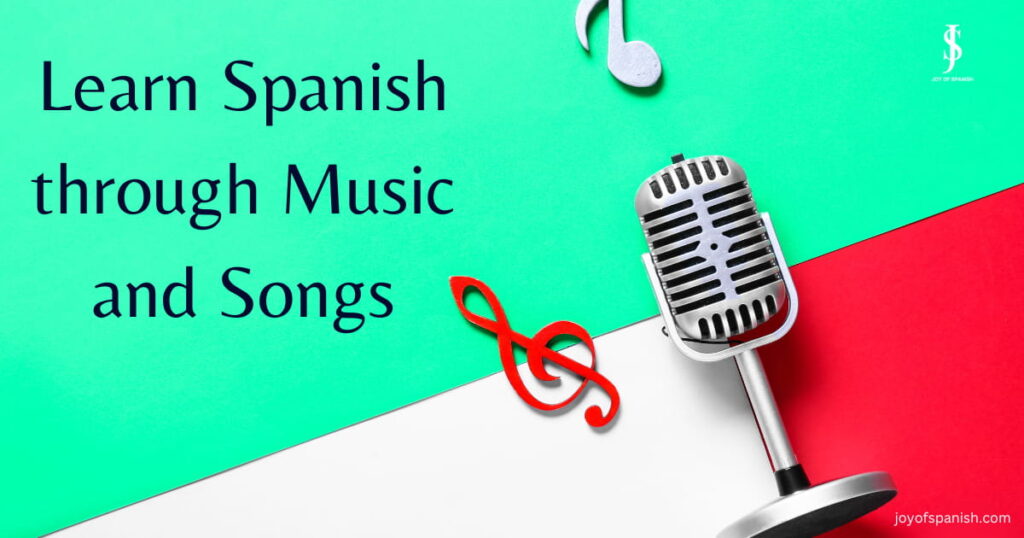
1. Busy Beavers — Kids Learning Videos
This channel features an array of educational videos for kids. This includes many songs and rhymes in Spanish.
2. Butterfly Spanish
This channel offers easy-to-follow videos that cover basic to intermediate Spanish.
The host is a native speaker, and she covers valuable words, phrases, and grammar rules.
3. Easy Spanish
This features interviews with native speakers on the streets of various Spanish-speaking countries.
It’s a fabulous way to practice listening skills and learn new terms and sayings. This can prepare you for various Spanish language exams.
4. Why Not Spanish
This Spanish learning YouTube channel is fantastic for intermediate and advanced learners. The hosts speak Spanish and cover various topics about Spanish culture, history, and current events.
5. SpanishDict
This YouTube channel offers easy-to-follow videos on Spanish grammar, vocabulary, and articulation. They also have videos that teach you how to speak Spanish like a native.
6. Professor Jason
The channel Professor Jason is incredible for beginners and intermediate learners. The videos cover grammar, vocabulary, and pronunciation. A Spanish teacher teaches all.
7. Spanish Mama
This popular YouTube channel for Spanish learners provides educational videos.
This is for parents who want to teach their children Spanish. The videos cover basic Spanish vocabulary, grammar, and pronunciation.
8. Spanish and Go
This channel showcases real-life conversations between two native Spanish speakers. It’s a splendid way to practice listening skills and learn new phrases and vocabulary.
9. Cocomelon – Nursery Rhymes
This famous channel offers a collection of nursery rhymes and Spanish songs perfect for young learners. It also has lots of animation videos for children and young learners.
10. Little Baby Bum
This channel includes a variety of nursery rhymes and songs in Spanish. This can help kids learn unfamiliar words and phrases.
The show circles around Mia, a young girl, her family, her counterparts, and animal-like characters.
11. KidsTV123
This channel covers educational videos and Spanish songs suitable for kids of all ages.
KidsTV123 has plenty of videos for kids, toddlers, and babies. It covers fundamental elements of the Spanish language.
12. Super Simple Songs – Spanish
This channel contains several simple songs and videos in Spanish. This is ideal for young learners.
YouTube comprises hundreds of videos of original kids’ songs and classic nursery jingles for young learners.
13. Español con Juan
This YouTube channel comprises many Spanish-language songs and videos. It can help you improve your listening comprehension and vocabulary.
Español con Juan features Juan, a Spanish teacher who offers fun and engaging lessons for all levels of learners. His videos cover grammar, vocabulary, and pronunciation.
14. Super Simple Español
This is a YouTube channel that covers various children’s songs in Spanish. These songs are simple and enjoyable. Thus, it is perfect for beginners.
15. Spanish Playlist
This YouTube channel features many popular Spanish-language songs, lyrics, and translations. This helps learners know the meaning of the lyrics.
16. Learn Spanish with Music
This YouTube channel has diverse Spanish video songs to help learners. You can improve your listening comprehension and vocabulary.
17. SpanishPod101
This YouTube channel features various Spanish-language lessons and resources. For example, music videos and songs.
The SpanishPod101 offers a comprehensive learning program for all levels of Spanish learners. They also have many interactive quizzes to help you improve your language skills through native speakers.
Spanish learning music app
There are many apps for learning Spanish music.
Here is a list of some Spanish-learning music apps you might find helpful. There is also a brief overview of each one.

1. Duolingo
Duolingo is a language education app with a gamified approach to help users learn new languages. It includes various listening and speaking exercises, interactive lessons, and quizzes.
The app also has a “Duolingo Radio” feature. This collection of music tracks helps users practice their listening skills. You can check the Duolingo review.
2. Busuu
Busuu is a language learning app that includes a variety of listening, reading, speaking, and writing exercises.
It also has a “Conversation Practice” feature. It allows users to have real-time dialogues with native speakers. The app includes music tracks meant to help users practice their listening abilities.
3. Rosetta Stone
Rosetta Stone is a well-known language-learning app that uses an immersive approach to teaching. It has many listening, speaking, reading, and writing exercises, interactive lessons, and quizzes.
The app also includes music recordings to help users practice their listening talents.
4. Babbel
Babbel is a language-learning app with hundreds of listening, writing, speaking, and reading tasks. You can also access interactive lessons and quizzes.
It also has many tasks and activities, allowing users to have real-time talks with native speakers. The app also includes music tracks to help users practice their listening skills.
5. iTalki
ITalki is a platform that connects language learners with native-speaking tutors. Here, you get one-on-one or group lessons.
It offers many Spanish teachers with various resources to help you learn Spanish. This includes listening and speaking exercises.
6. LyricsTraining
You can discover a new and fun way to learn Spanish by LyricsTraining. Study by filling in the missing lyrics while listening to your favorite videos and songs.
You can practice with relevant content. For example, videos, text, and podcasts for improving Spanish from various sources on the internet. You can access the content anytime from Android, iOS, and the Web.
How to find music to help you learn Spanish?
Are you interested in learning Spanish through music?
In that case, there are many outstanding artists and songs that you might find helpful. With some trial and error, you will find many enjoyable and helpful music for learning Spanish.
Here are some tips and suggestions to help you find the right music for your Spanish studies.
1. Look for songs with simple, repetitive lyrics
In the beginning, aim for easy-to-understand songs. The repetitive lyrics can help you learn new vocabulary and improve pronunciation.
Listening to easy-to-understand and repetitive lyrics is effortless to follow and memorize. It is also fun to practice and enrich listening and speaking skills.
2. Find songs you enjoy
Finding the music you enjoy is a must. This can make learning more engaging.
The key is to find music that you enjoy. Listen per your current Spanish level and what suits you best.
3. Songs with translations in Spanish and your mother tongue
Having the lyrics in both Spanish and your native language can help you understand the meaning of the words.
This way, you can practice effectively and improve your listening comprehension.
4. Try listening to a variety of different genres
Experiment with different genres of music to see what you enjoy and find most helpful for learning Spanish.
There is a wide variety of Spanish music. For example, jazz, reggaeton, pop, rock, salsa, and extensive local types. Experiment with different genres to find the styles of music that you enjoy the most.
5. Start with familiar songs
Choose songs that you already know and enjoy in your mother tongue.
Look up the lyrics in Spanish and try singing along with the Spanish version. This can help you realize the language’s rhythms and sounds.
As you become more familiar with the lyrics, try listening to the songs without looking at the lyrics. This can help you improve your listening comprehension crafts and understand spoken Spanish.
Concluding Thoughts on Learning Spanish Through Music
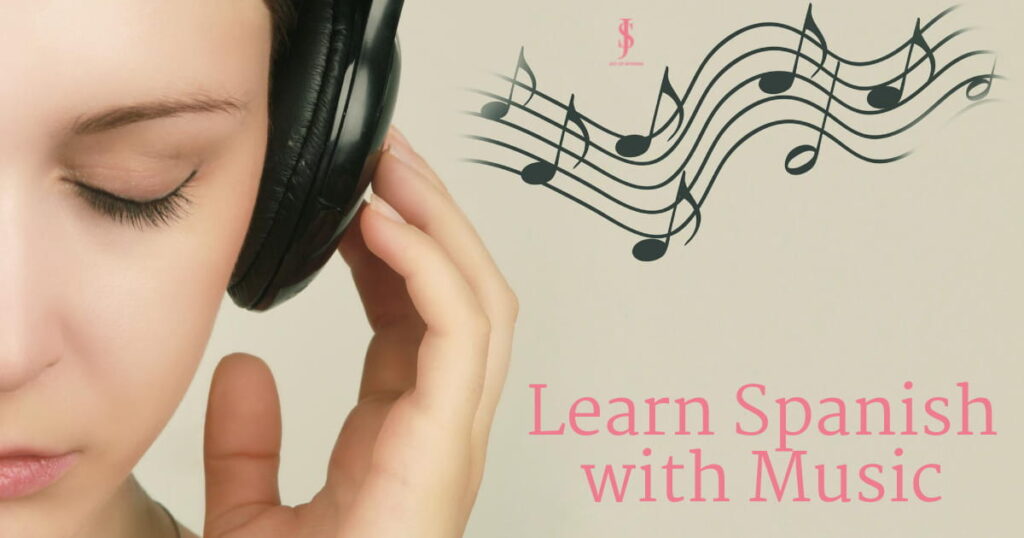
Apart from movies and TV shows to learn Spanish, music can be an effective tool. It is a fun way to practice the language.
The lyrics can help you learn new words and phrases. You can improve your spoken Spanish comprehension. It also enhances your understanding of context and improves accents and pronunciation.
Focus on how to speak the words and try to mimic the sounds as much as possible. Look up any words or terms you don’t understand and try to memorize them.
Online platforms and apps give access to popular Spanish songs. You can read lyrics, translations, and explanations. It makes it easier to follow along and understand the content.
To learn Spanish, you need to invest time and effort. Adding music to your routine can enhance the experience and make it more satisfying.
Do you have any thoughts or questions to add? Please leave your opinions in the comment section.
